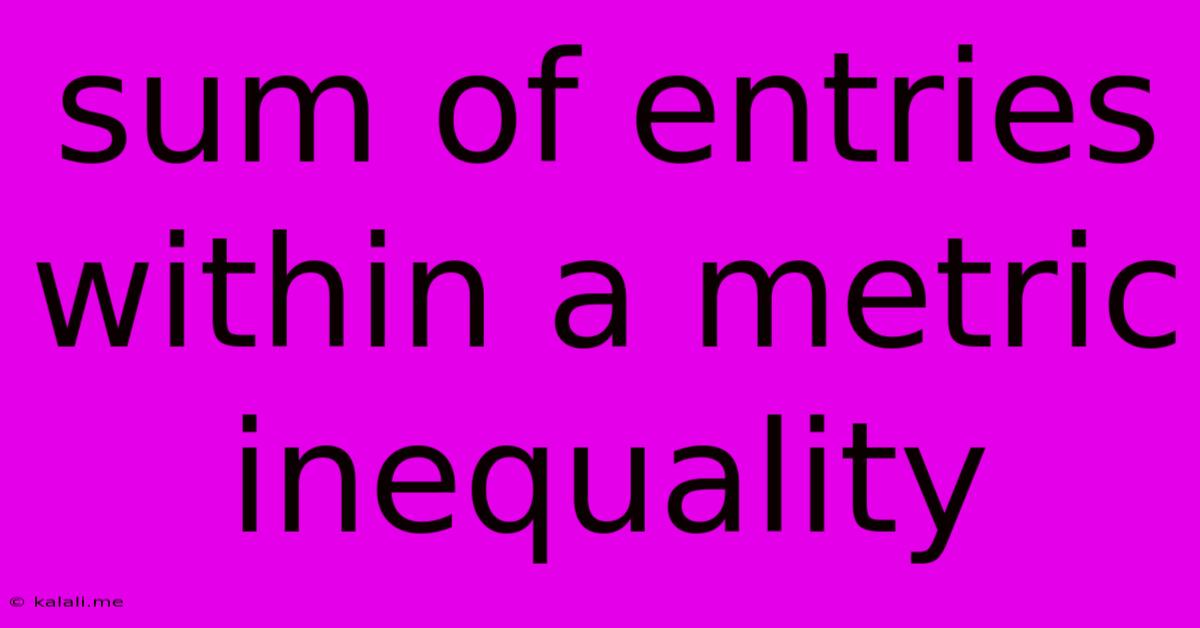Sum Of Entries Within A Metric Inequality
Kalali
May 23, 2025 · 3 min read

Table of Contents
Understanding and Solving Inequalities with Summation of Entries
This article delves into the fascinating world of inequalities, specifically focusing on problems involving the sum of entries within a given metric. We'll explore various techniques and approaches to tackle such problems, providing clear explanations and practical examples to enhance your understanding. This is a crucial area in many fields, including linear algebra, optimization, and computer science.
What are we talking about? We're examining inequalities where the unknown variables are elements of a vector or matrix, and the inequality involves the sum of these elements (or some function of the sum). This often involves understanding the properties of norms, inner products, and other metric concepts.
Types of Inequalities Involving Summation
Several types of inequalities involve summing elements within a defined metric. Here are a few key examples:
-
Triangle Inequality: This fundamental inequality states that for any vectors x and y in a normed vector space, ||x + y|| ≤ ||x|| + ||y||. Understanding this inequality is key to many other concepts. Variations exist depending on the specific norm used (e.g., L1 norm, L2 norm, etc.).
-
Cauchy-Schwarz Inequality: This inequality relates the inner product of two vectors to their individual norms: |⟨x, y⟩| ≤ ||x|| ||y||. It's a powerful tool in proving other inequalities and finding bounds on expressions.
-
Hölder's Inequality: A generalization of the Cauchy-Schwarz inequality, Hölder's inequality deals with the L<sup>p</sup> norms and provides a bound for the sum (or integral) of the product of two functions.
-
Minkowski Inequality: This inequality relates the L<sup>p</sup> norms of the sum of two vectors. It's closely connected to Hölder's inequality.
Techniques for Solving Inequalities with Summation
Solving inequalities involving summations often requires a combination of algebraic manipulation, properties of the specific metric involved, and sometimes, clever application of other inequalities. Here are some common strategies:
-
Applying known inequalities: Start by identifying if the inequality resembles a known inequality like the triangle, Cauchy-Schwarz, Hölder, or Minkowski inequalities. If so, you can often directly apply these to simplify or solve the problem.
-
Rearrangement and algebraic manipulation: Rewrite the inequality to isolate the sum of entries. This might involve factoring, expanding, or using substitution.
-
Induction: For inequalities involving sums over a discrete set of indices, mathematical induction can be a powerful tool to prove the inequality holds for all n.
-
Bounding techniques: Find upper and lower bounds for the individual terms in the sum. This can help establish an overall bound for the entire sum.
-
Optimization techniques: If the inequality is related to an optimization problem (e.g., minimizing or maximizing a sum subject to constraints), techniques from linear programming or other optimization methods might be helpful.
Example Problem: Triangle Inequality in R<sup>2</sup>
Let's consider a simple example using the triangle inequality in two-dimensional Euclidean space (R<sup>2</sup>). Suppose we have two vectors, x = (x₁, x₂) and y = (y₁, y₂). The Euclidean norm (L2 norm) is defined as ||x|| = √(x₁² + x₂²). The triangle inequality states:
||x + y|| ≤ ||x|| + ||y||
This translates to:
√((x₁ + y₁)² + (x₂ + y₂)²) ≤ √(x₁² + x₂²) + √(y₁² + y₂²)
To prove this, we'd need to use algebraic manipulation and perhaps square both sides to simplify the expression, eventually showing that the inequality holds. This demonstration usually involves showing that the square of the left side is less than or equal to the square of the right side.
Conclusion
Inequalities involving the sum of entries within a given metric are a rich and important area of mathematics with broad applications. Mastering the techniques outlined above, combined with a strong understanding of different metric spaces and their properties, will provide you with the tools to tackle a wide range of challenging problems. Remember to carefully consider the specific type of inequality and the properties of the underlying metric space when choosing your approach. Practice is key to developing proficiency in this area.
Latest Posts
Latest Posts
-
Which Word Has The Most Positive Connotation
Jul 15, 2025
-
How Do I Send An Evite Reminder
Jul 15, 2025
-
When Performing A Self Rescue When Should You Swim To Shore
Jul 15, 2025
-
How Many Decaliters Are In A Liter
Jul 15, 2025
-
What Note Sits In The Middle Of The Grand Staff
Jul 15, 2025
Related Post
Thank you for visiting our website which covers about Sum Of Entries Within A Metric Inequality . We hope the information provided has been useful to you. Feel free to contact us if you have any questions or need further assistance. See you next time and don't miss to bookmark.